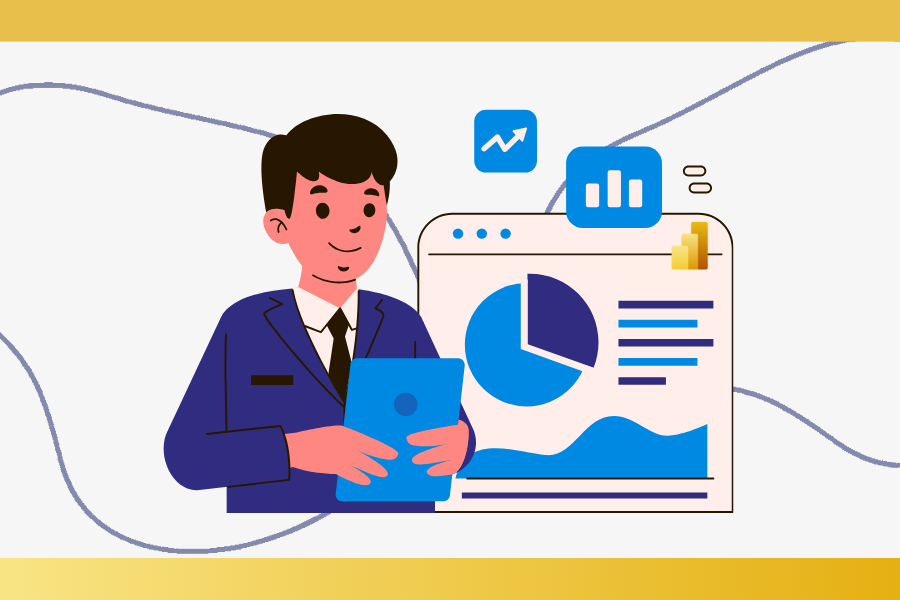Interestingly, the importance of business intelligence is growing not only in large B2C corporations that track customer behavior but, more importantly, in B2B companies, where speed of decision-making and process optimization often determine whether a company thrives or struggles in the market.
So, who’s behind all this? Who makes data “speak” the language of business? This is where the Power BI analyst comes in — a specialist who combines technical skills with a deep understanding of a company’s business needs. And that’s exactly who we’ll focus on in today’s article.
Who is a Power BI analyst?
Have you ever wondered who turns seemingly chaotic Excel spreadsheets and ERP data into clear, actionable reports? That’s exactly the role of the Power BI analyst — someone who operates at the intersection of data, technology, and business.
Put simply, a Power BI analyst is a specialist who combines technical expertise with the ability to understand business requirements. Their job isn’t just to design attractive dashboards — it’s to transform raw data into practical insights that help companies make smarter decisions.
What does a Power BI analyst do?
The daily responsibilities of a Power BI analyst go far beyond creating charts. Here’s what this role really involves:
- Integrating data from various sources – ERP systems, CRM platforms, Excel sheets, email campaign data, and social media. The data may come from different places, but it’s the analyst’s job to organize and merge it into a cohesive whole.
- Creating reports and dashboards – not just visually appealing, but intuitive, up-to-date, and tailored to the needs of business users.
- Analyzing and visualizing data – uncovering insights and trends that were previously hidden in rows of numbers.
- Collaborating with business teams – analysts need to understand how departments like sales, finance, or logistics operate in order to deliver value — not just colorful charts.
What Skills Should a Power BI Analyst Have?
On one hand, it’s someone who feels completely at home with code and data structures. On the other — someone who can walk into a conference room and explain, in simple terms, why sales plummeted in the southern region this quarter.
Hard skills
These are the foundations of every Power BI analyst’s work:
- Strong knowledge of Power BI – including Power Query and DAX, which is essential for building advanced measures and calculations.
- Proficiency in SQL – useful both for working directly with databases and for writing complex backend queries.
- Understanding of database structures – how relationships work, and the difference between star and snowflake schemas. A Power BI analyst should be confident with these concepts.
- Experience with Microsoft Fabric, and Data Warehouses – particularly relevant in larger organizations where data is stored in more advanced environments.
Soft skills
Even the best report can go unnoticed without these:
- Analytical thinking – the ability to spot patterns and connections that others might miss.
- Business communication – a Power BI analyst should be able to speak not just to fellow data professionals but also to stakeholders who don’t live and breathe data.
- Storytelling with data – because every chart tells a story — the key is knowing how to translate it into business-relevant insights.
Can anyone become a Power BI analyst?
A quick Google search or a short scroll through LinkedIn reveals one thing: Power BI is everywhere. There’s no shortage of online courses, YouTube tutorials rack up hundreds of thousands of views, and the Power BI community is growing fast. More and more people are learning Power BI on their own — and that’s great!
But here comes the real question – Is that enough to independently implement a professional BI solution in a company?
Why being a Power BI analyst is not easy ?
At first glance, it all looks simple: a neat dashboard, a few slicers, maybe a bar chart or two. But behind the scenes? It’s a completely different story. The real work of a Power BI analyst starts where the basic features of Power BI Desktop end.
Complex data integration from multiple sources
ERP, CRM, Excel, SharePoint, APIs, flat files, email campaign data… Sometimes the data lives in five different systems that don’t “talk” to each other. It’s the analyst’s job to connect, clean, and standardize it — and do it in a way that doesn’t break with the next data refresh.
Building efficient and scalable data models
It’s not enough for a report to work — it needs to work fast. That’s why skills in data modeling, DAX optimization, and applying best practices are absolutely essential.
Continuous learning in a rapidly changing environment
Power BI and Microsoft Fabric are evolving at lightning speed. New features are released every month, and yesterday’s best practices can quickly become outdated. An analyst who doesn’t keep learning will quickly fall behind.
Responsibility for data quality and business decisions
A BI analyst is not just a “chart person.” They’re the ones delivering the data that drives real business decisions — often involving hundreds of thousands of dollars. A miscalculation or misinterpreted trend? That’s not just a reporting error — it’s a potential business risk.
A simple dashboard? Sometimes it’s weeks of work
Let’s look at an example. A client requests a basic sales dashboard — sales vs. target, a regional map, and top-selling products. Sounds simple, right? Not quite. Before the visualizations even begin, the analyst must:
- map out all relevant data sources,
- build a robust and sustainable data model,
- account for seasonality and sales targets at both regional and product levels,
- ensure performance and compliance with GDPR,
- and test everything thoroughly with historical data.
This isn’t just about “making a chart.”
It’s a complex process that demands experience, technical expertise, and a sharp understanding of business context.
Why you should trust experienced Power BI specialists
In theory, implementing Power BI may seem straightforward.
In practice? It’s a minefield that can cost your business time, money, and unnecessary stress. That’s why it’s worth partnering with experts who’ve delivered dozens of successful deployments — and know exactly what to avoid.
Experience makes all the difference
A team that designs Power BI and Microsoft Fabric solutions daily understands that every implementation is unique: different data sources, different business logic, different reporting needs. That experience means we’re not learning on your project — we’re delivering proven solutions from day one.
Why outsourcing Power BI analysts is a smart move
When you outsource your BI project to a specialized partner, you get more than just a few dashboards:
- Faster project launch – no recruitment, onboarding, or internal training required. Specialists are ready to start from day one.
- Access to the latest expertise – Business Intelligence technology evolves rapidly. Our consultants stay on top of every Power BI and Microsoft Fabric update.
- Fewer costly mistakes – real-world experience helps avoid common pitfalls that can delay or derail internal BI implementations.
End-to-end implementation support
Power BI implementation is more than building a dashboard. It includes:
- data integration from ERP, CRM, Excel, social media, and more,
- efficient data model design,
- customized reporting tailored to different user roles,
- training your team in data analysis and report usage.
A good implementation partner takes care of everything — with structured procedures, full documentation, and alignment with your business needs.
Efficiency and security you can rely on
An external team works methodically: project planning, timelines, testing, quality assurance. No chaos, no guesswork. Everything is documented and professionally managed — making it a far safer approach than building a BI environment in-house, especially for larger organizations.
Thinking about outsourcing Power BI in your company?
Let’s talk. Schedule a free consultation with our experts and get tailored advice on the right solutions and tools for your business.

